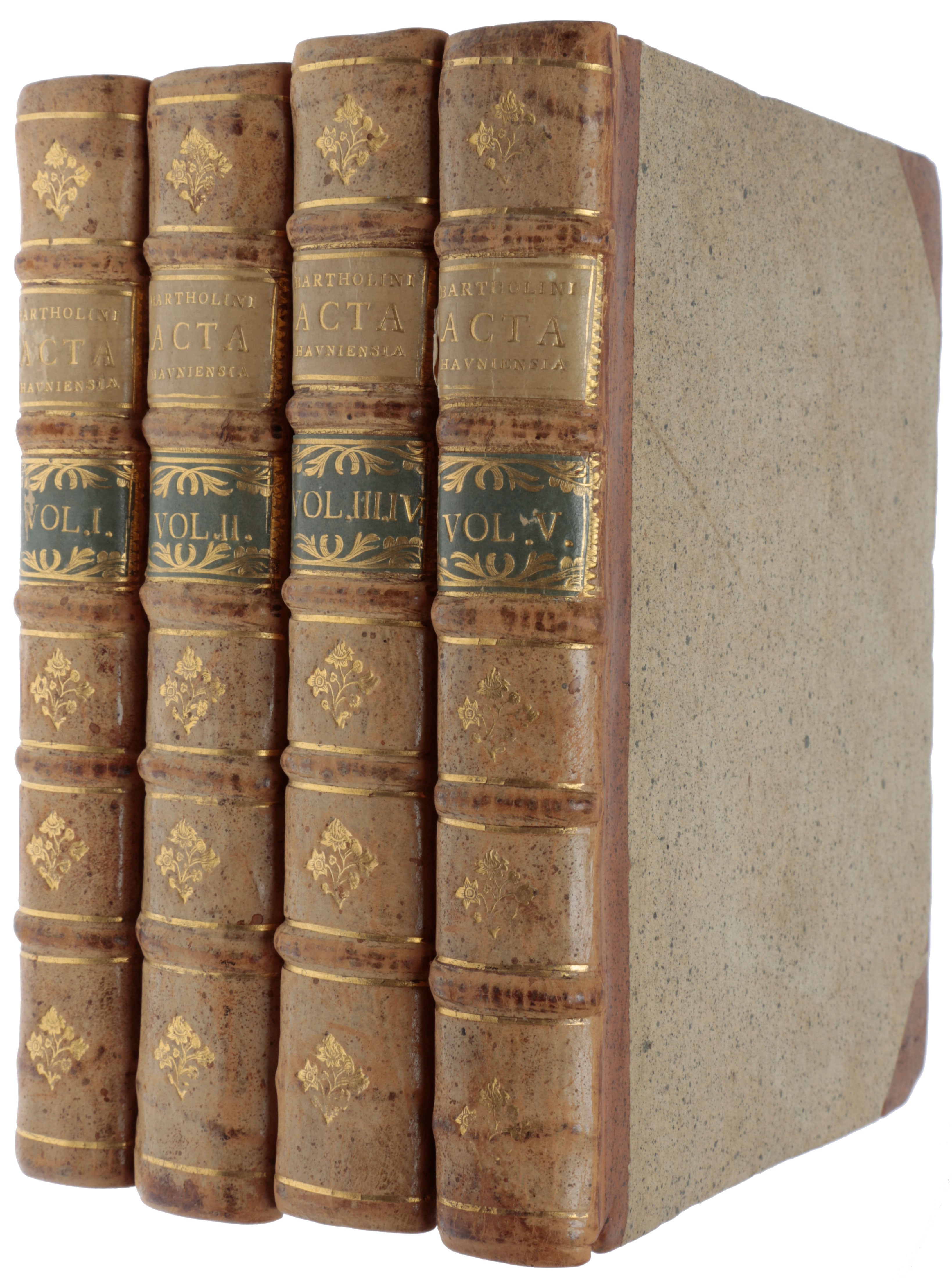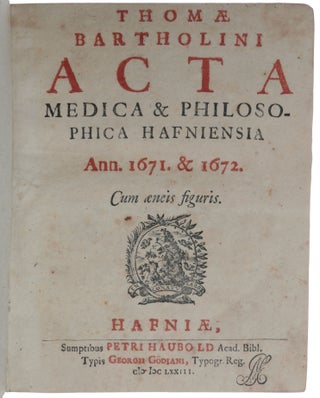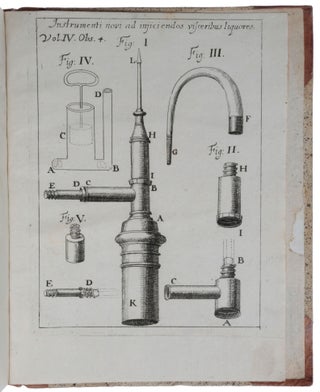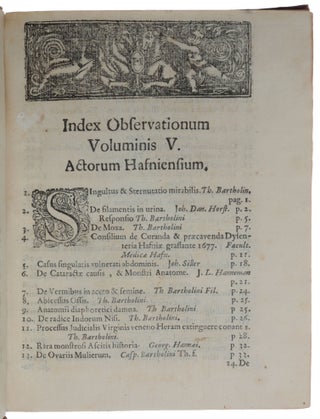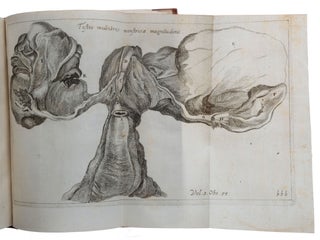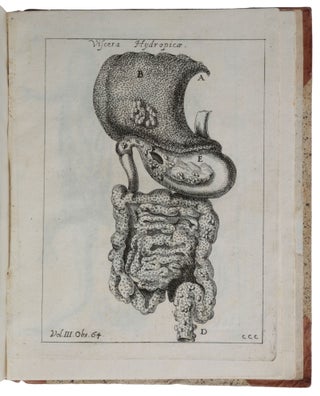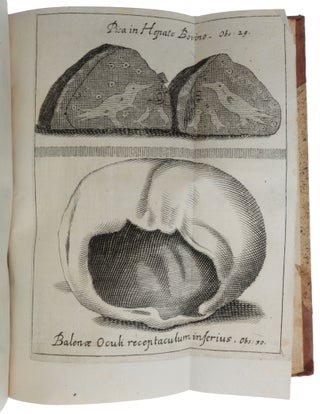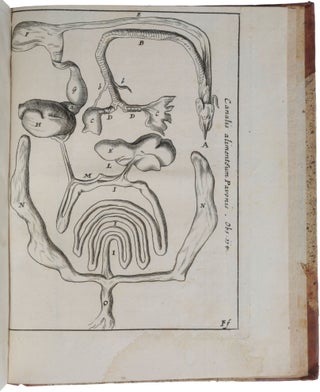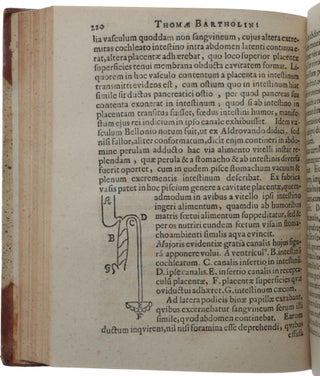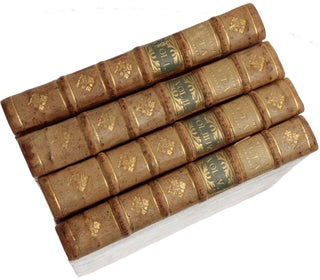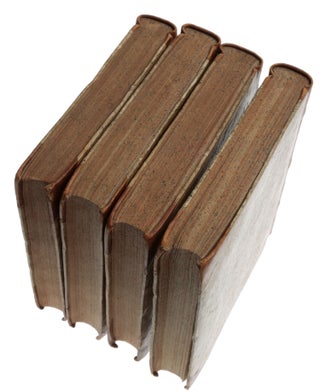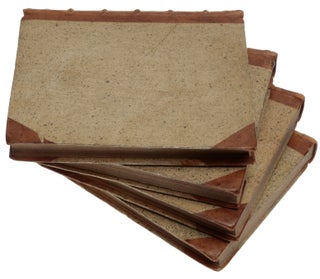Acta Medica & Philosophica Hafniensia.
Hafniae [Copenhagen]: Peter Haubold, 1672-80. First edition, a rare complete run, of one of the first medical journals, and Denmark’s first scientific journal. While Garrison (p. 301) lists three previous journals, two of these were published for just one issue; only the Giornale dei letterati (Parma, 1668-88) predates this. Among the many significant contributions in these volumes, including more than 100 by Bartholin himself, are the last published scientific works of Niels Stensen. Stensen returned from Italy to Denmark in 1672 to accept an appointment at the University of Copenhagen under Bartholin. During his stay he carried out a number of experiments, two of which are published in vol. I: ‘Embryo monstro as finis Parisiis dissectus’ (pp. 200-203) and ‘Uterus Leporis Proprius, foetum resolventis’ (pp. 203-207). During his stay in Italy, however, Stensen converted to Catholicism and found himself the target of attack from orthodox Protestants. He became more interested in theological debates that scientific research and in 1674 he returned to Florence and in 1685 took Holy Orders. “The Copenhagen biologists, under the quickening influence of Thomas Bartholin, produced five volumes of transactions known as the Acta Medica et Philosophica Hafniensia, which is now very rare and almost entirely forgotten” (Cole). The leading authors besides Thomas Bartholin and Niels Stensen (Steno) were Holger Jacobsen (Jacabaeus), Caspar Bartholin, Ole Borch (Borrichius), Ole Worm, Simon Paulli, Johan Rodhe, Caspar Kolichen and several others. “In the case of many of their observations the interest is rather in the odd and curious, the astounding and marvelous, the unnatural and the abnormal Monsters and freaks of nature receive perhaps the most attention” (Thorndike). The collation of this copy agrees with that digitized on BSB (including the absence of the separate title page to Vol. IV). “Thomas Bartholin was the son of the professor of anatomy in Copenhagen Caspar Bartholin, the author of a widely used book on anatomy. After studies at home in 1634-37 he went for a long academic peregrination to Leiden, Paris, Montpellier, Padua, Basel and Amsterdam. He returned to Copenhagen in 1646 when called as professor. Bartholin performed his first public anatomy there in 1649. He became universally renowned for the reformed and illustrated edition of the anatomy book of his father published in several editions and translations. “Thomas Bartholin edited and wrote numerous papers and books. His main achievement in science was the discovery of the web of tiny lymphatic vessels widely distributed in the body that was published in his Vasa lymphatica in 1653. A fierce public dispute on priority ensued with the Swedish anatomist Olaf Rudbeck who made simultaneous discoveries. Afterwards Thomas Bartholin laid down the anatomical scalpel to serve Copenhagen University in different disciplines to become an influential rector. “Niels Stensen, or Nicolaus Stenonis, shortened Steno, the son of a goldsmith, studied medicine with Thomas Bartholin as his preceptor in 1656-59, a turbulent period with warfare between Denmark and Sweden in which Copenhagen for a long period was besieged. Stensen went abroad for studies in Amsterdam and Leiden. He was the first to described the excretory ducts of the parotid and the tear glands. Stensen and Bartholin’s letter communication shows their mutual respect and interest in research. However, not being offered a position at Copenhagen University, Stensen went on to Paris where he gave a famous Discourse on the Anatomy of the Brain in 1665. Stensen moved to become scientist to the court of the Grand Duke of Tuscany in Florence. There he concluded his studies on the muscles describing a model of muscular contraction in his Specimen of Elements of Myology in 1667. “When requested by the Grand Duke Ferdinand II, he dissected the head of a huge Carcharodon shark caught off the coast of Livorno. Stensen reflected on the likeness of its teeth and the well-known tongue stones, glossopetrae, found in rocks of Malta. He concluded that he found no objections against such fossils being remnants of fishes from a sea that in the past had flooded the rocks where they are now found. Stensen formulated several basic principles of the geological sciences in books published in 1667 and 1669. “At that time Stensen abandoned the Lutheran faith and converted to the Roman Catholic Church. By this step he disqualified himself from obtaining a position at the university in his orthodox Lutheran homeland. Thus, when called back by the king of Denmark, Norway and Iceland, Christian V, Stensen was offered a modest salary to function as ‘Royal Anatomist’ from 1672. This function was to last for only two years. “As Royal Anatomist Stensen performed dissections in about thirty different animal species and in two human bodies in Copenhagen. Most of this activity took place in private premises with small audiences of interested students among whom Holger Jakobsen and Thomas Bartholin’s son Caspar Bartholin, jr. … “Stensen’s ten reports printed in the Acta Hafniensia are listed [below]. It is worth noticing that several were written on dissections performed in Paris, Florence and Innsbruck” (Kardel & Maquet, pp. 49-51). “Steno, stimulated by his important researches on the female genital ducts and ova of the terrestrial vivipara, turned his attention to fishes. He gives an account in shark Mustelus of a functional placenta. He gives also, in Mustelus and Acanthias, one of the earliest descriptions and figures of the elasmobranch spiral intestine, which he names ‘intestinum cochleatum’. In Torpedo he describes the electric organ, its characteristic vertical prismatic columns, and the nerve supply. Steno’s dissections of the muscles of the eagle, Aquila (1673) is one of the most remarkable essays in zootomy published up to his time, and it is perhaps more detailed and reliable than almost any other. Steno also published a series of nine drawings of the thoracic duct and associated lymphatics of the dog” (Cole). The first volume of the Acta (pp. 274-278) contains the first ever report of an anatomical examination of a reindeer, written by Bartholin while the dissection was made by Stensen. Cole, A History of Comparative Anatomy from Aristotle to the eighteenth Century, 1944. Garrison, ‘Medical and scientific periodicals of the 17th and 18th centuries,’ Bulletin of the Institute of the History of Medicine 2 (1934), pp. 285-343. Kardel & Maquet, ‘Anatomy of a reindeer dissected in Copenhagen in 1672 by Niels Stensen as reported by Thomas Bartholin,’ Rangifer 32 (2012), pp. 49-56.
Thomas Bartholin describes the male mandrill illustrated by three anatomical plates (Male genitalia) and a figure of the entire animal, which had died of disease in the Royal Menagerie. Holger Jacobsen describes the scorpion, the salamander, snakes, several birds, the heron and the parrot (based on dissections and figures by Steno). He also investigated the fascinating and unique anatomical puzzle of the tongue of the black woodpecker (with plate). He gives an exceptionally interesting account of the mole cricket, Gryllotalpa, which is important as being one of the first in which the elongated segmental heart of insects is described and figured. This memoir is a commendable piece of zootomical research, and all the more outstanding because the subject of it was an invertebrate” (ibid.).
Five vols. bound in four, 4to (182 x 147 mm). Vol. I: pp. [xvi], 1-23, 34-148, 159-316, with 16 plates (numerous mispaginations); vol. II: pp. [xx], 376, with 24 plates; Vols. III/IV: pp. [xvi], 1-99, 98-174; 1-216 with 15 plates [no title page for vol. IV was issued]; Vol. V: pp. [viii], 342 with 8 plates (some gatherings with moderate browning). These five volumes contain together 63 engraved plates (two folding) and numerous woodcuts in the text. Uniformly bound in contemporary half-calf (hinges and boards with some wear, some superficial leather restoration to surface).
Item #5627
Price: $20,000.00

